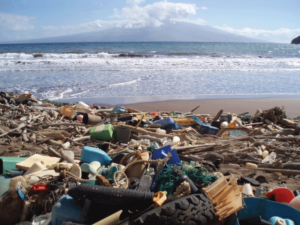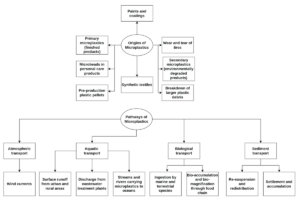A Theoretical Overview of Microplastic Pollution: A Complex Threat to Marine Ecosystems, Human Health, and the Environment
Microplastic Pollution: A Multifaceted Threat to Marine Ecosystems, Human Health, and the Environment
Microplastic pollution has emerged as a global crisis with far-reaching implications for ecosystem science, toxicology, and public health. These microscopic plastic particles, derived from diverse sources, infiltrate marine environments, disturb ecological balance, and threaten human well-being. Their prevalence across various ecosystems underscores the urgent need for comprehensive research and strategic interventions.
This blog explores microplastic pollution through the lens of ecosystem science and toxicology, examining its origins, impacts, and potential solutions.
Figure : 1 Plastic debris from Kanapou Bay, on one of the islands of Hawaii. (Image credit: NOAA)
Understanding Microplastics
Microplastics are tiny plastic particles measuring less than 5 millimeters. They are categorized into:
- Primary Microplastics: Manufactured small particles, such as microbeads in personal care products and plastic nurdles used in manufacturing.
- Secondary Microplastics: Result from the breakdown of larger plastics through physical, chemical, and biological processes.
These particles are pervasive across aquatic systems, sediments, and even terrestrial environments, posing unique challenges for ecosystem science and toxicology.
Figure :2 The detailed flow for the origin and pathways of microplastics
Sources and Pathways of Microplastics
Microplastics enter marine ecosystems through several pathways:
- Urban Runoff: Rainwater washes plastic debris into rivers and oceans.
- Wastewater Effluents: Incomplete filtration of microplastics during sewage treatment allows them to escape into waterways.
- Direct Dumping: Littering and improper disposal of plastics contribute significantly to marine pollution.
- Atmospheric Deposition: Airborne microplastics settle into water bodies or soil, highlighting their ubiquity.
Once introduced, microplastics are dispersed by currents, tides, and winds, infiltrating diverse ecosystems and presenting significant challenges for ecosystem science.
Impact on Marine Ecosystems
1. Threats to Marine Organisms
Microplastics pose a direct threat to marine organisms, from plankton to large mammals:
- Ingestion: Many marine animals mistake microplastics for food, leading to blockages in their digestive systems.
- Chemical Contamination: Plastics adsorb toxic substances, including pesticides and heavy metals, which are released upon ingestion.
These interactions are central concerns for ecosystem science and toxicology, as they disrupt food webs and result in bioaccumulation of harmful substances.
2. Habitat Degradation
Accumulations of microplastics alter the physical and chemical properties of habitats:
- Coral reefs are smothered, reducing their ability to support marine biodiversity.
- Sediment composition changes impact benthic organisms, disrupting ecological processes.
3. Disruption of Ecosystem Functions
Microplastics interfere with fundamental ecological functions:
- Nutrient cycling is impacted by altered sediment dynamics.
- Predator-prey relationships shift as species adapt to new stressors.
From an ecosystem science perspective, these disruptions highlight the cascading effects of pollution on biodiversity and ecosystem stability.
Human Health and Toxicology
Microplastics have entered the human food chain through seafood, drinking water, and even airborne particles. The field of toxicology is increasingly focused on understanding their effects on human health.
1. Cellular and Systemic Toxicity
Microplastics can penetrate cellular membranes, leading to:
- Oxidative Stress: An imbalance between free radicals and antioxidants, damaging cells.
- Cytotoxicity: Toxic effects on cell structure and function.
- Inflammatory Responses: Persistent exposure causes chronic inflammation in tissues.
2. Endocrine Disruption
Certain plastics release endocrine-disrupting chemicals, such as phthalates and bisphenol A (BPA). These substances mimic hormones, potentially causing:
- Reproductive health issues.
- Developmental disorders.
- Hormonal imbalances.
3. Long-Term Health Risks
While research is still emerging, prolonged exposure to microplastics may contribute to:
- Metabolic disorders.
- Increased cancer risk.
- Neurodegenerative conditions.
For toxicology, understanding the dose-response relationship and chronic effects of microplastics remains a critical area of research.
The Role of Ecosystem Science in Microplastic Pollution
1. Mapping Microplastic Distribution
Ecosystem science employs advanced tools to map the presence and concentration of microplastics in different habitats:
- Remote sensing and geographic information systems (GIS) provide large-scale spatial data.
- Field studies collect sediment, water, and biological samples to analyze contamination patterns.
2. Studying Ecosystem Responses
Research focuses on how ecosystems respond to microplastic stressors:
- Species diversity and population dynamics are monitored to identify vulnerable groups.
- Ecosystem functions, such as nutrient cycling and primary productivity, are studied to assess long-term impacts.
3. Restoration Strategies
Ecosystem science contributes to developing strategies to restore habitats affected by microplastics:
- Bioremediation techniques using microorganisms to degrade plastics.
- Habitat restoration programs that focus on improving resilience against pollution.
Toxicological Insights into Microplastics
1. Adsorption and Desorption of Toxins
Microplastics act as vectors for environmental pollutants:
- They adsorb persistent organic pollutants (POPs), such as polychlorinated biphenyls (PCBs) and dioxins.
- Desorption occurs in biological systems, releasing these toxins into the body.
2. Nanoplastics and Enhanced Toxicity
When plastics degrade into nanoparticles, their surface area increases, enhancing:
- Interaction with cellular structures.
- Potential to cross biological barriers, such as the blood-brain barrier.
3. Cross-Species Impacts
Toxicological studies reveal how microplastics affect multiple trophic levels:
- From plankton, which form the base of the food web, to apex predators, the effects cascade across ecosystems.
These findings inform both ecosystem science and toxicology, guiding policies and interventions.
Mitigation Strategies
1. Policy Interventions
Governments and international organizations play a key role in curbing microplastic pollution:
- Bans on Single-Use Plastics: Prohibiting items like straws, bags, and microbeads.
- Regulation of Industrial Effluents: Ensuring wastewater treatment plants effectively capture microplastics.
2. Technological Solutions
Innovations focus on reducing plastic waste and filtering microplastics:
- Biodegradable plastics offer an eco-friendly alternative.
- Advanced filtration systems for wastewater treatment remove microplastics before they reach aquatic ecosystems.
3. Public Awareness
Educating communities on the dangers of microplastics empowers individuals to make sustainable choices:
- Reducing plastic consumption.
- Participating in cleanup drives and recycling programs.
4. International Collaboration
Addressing microplastic pollution requires global cooperation:
- Cross-border agreements on plastic waste management.
- Joint research initiatives in ecosystem science and toxicology to develop innovative solutions.
Future Directions in Research
1. Bridging Ecosystem Science and Toxicology
The integration of ecosystem science and toxicology will drive a deeper understanding of microplastic impacts:
- Examining how ecological and physiological processes interact under pollution stress.
- Developing predictive models to anticipate long-term impacts.
2. Advancing Analytical Techniques
Emerging tools, such as mass spectrometry and nanotechnology, will enhance detection and analysis of microplastics:
- Identifying specific polymers and their associated toxins.
- Understanding their behavior in complex biological and environmental systems.
3. Evaluating Biodegradable Alternatives
Research must assess the lifecycle impacts of biodegradable plastics:
- Analyzing degradation rates and byproducts.
- Ensuring these alternatives do not introduce new environmental risks.
Conclusion
Microplastic pollution is a critical environmental challenge that intersects with ecosystem science, toxicology, and public health. Its pervasive nature threatens marine ecosystems, disrupts ecological processes, and poses significant risks to human health. Addressing this issue requires a multidisciplinary approach, combining policy reforms, technological innovations, and public engagement.
Through the lens of ecosystem science, we can map contamination and develop restoration strategies. From a toxicology perspective, understanding the health impacts of microplastics is essential for safeguarding future generations. Together, these fields provide the foundation for a sustainable response to the microplastic crisis.
FAQ’s :
1 .What are microplastics, and where do they come from?
A:Microplastics are tiny plastic particles under 5 millimeters, originating from primary sources like microbeads or secondary sources through the breakdown of larger plastics.
2.How do microplastics affect marine ecosystems?
A:Microplastics harm marine life through ingestion, chemical contamination, habitat disruption, and interference with ecological functions like nutrient cycling.
3.What are the potential health risks of microplastic exposure to humans?
A:Microplastics can cause cellular damage, inflammation, oxidative stress, endocrine disruption, and potentially lead to long-term health risks like cancer or metabolic disorders.
4.How can we mitigate the impact of microplastic pollution?
A:Effective strategies include banning single-use plastics, developing biodegradable alternatives, improving wastewater filtration, and raising public awareness about sustainability.
5.Why is interdisciplinary research critical in addressing microplastic pollution?
A:Combining ecosystem science and toxicology provides insights into ecological and health impacts, enabling the development of targeted policies and solutions.
Lorem ipsum dolor sit amet, consectetur adipiscing elit. Ut elit tellus, luctus nec ullamcorper mattis, pulvinar dapibus leo.
